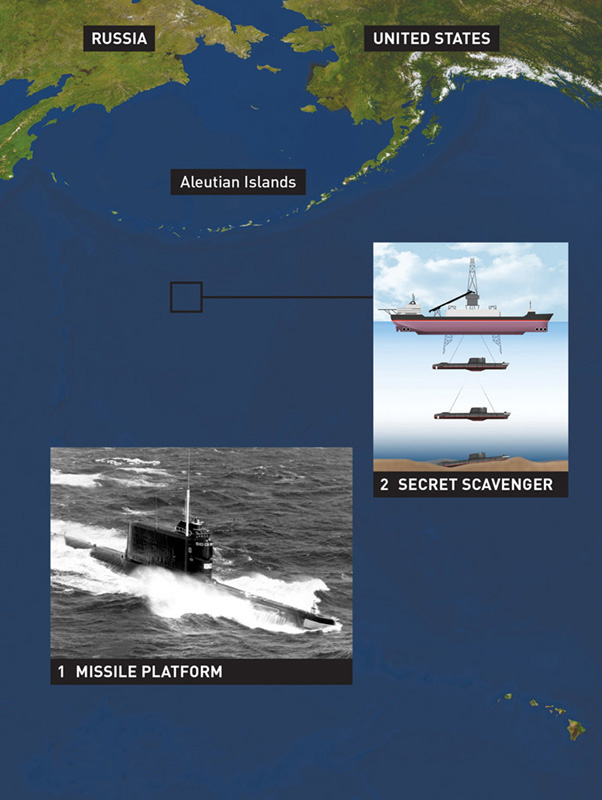
LOCATION Beneath the Pacific Ocean
NEAREST POPULATION HUB Petropavlovsk, Russia
SECRECY OVERVIEW Location uncertain: a sunken submarine at the heart of a Cold War mystery.
The K-129 was a nuclear-equipped submarine that sailed as part of the Soviet Pacific Fleet. After sinking in unknown circumstances in 1968, it was located by US forces, who subsequently attempted to raise it in a covert “black op.” While some of the wreckage was retrieved, much remains in the sea—exactly what the Americans found, and in what circumstances, remains a mystery to this day.
Launched in 1960, the K-129 was based at the Rybachiy Naval Base in Russia’s far eastern Kamchatka region. On February 24, 1968, the vessel and her 98 crew set out on a scheduled patrol and, after undertaking a deep-sea test dive, the captain reported that all was well. Nothing more was ever heard from the sub.
In March 1968, Soviet naval headquarters implemented a massive search and rescue effort across the North Pacific. They failed to find the submarine, but their efforts attracted the attention of American intelligence. By analyzing data from its underwater Sound Surveillance System, the US pinpointed the resting place of the K-129, almost 5,000 meters (16,500 ft) beneath the waters of the Pacific.
Confronted with the opportunity to get his hands on one of the USSR’s nuclear fleet, President Nixon authorized a top secret salvage attempt known as Project Azorian. A bespoke vessel, the Hughes Glomar Explorer, was built especially for the job. The cover story was that the ship was to be used for mining manganese nodules from the seabed.
The salvage operation, carried out during July and August 1974, had mixed results. Some of the vessel was recovered, but a large section fell back to the seabed when technical equipment failed. The exact location of the wreck and details of the operation remain top secret, but it has been speculated that the US left the scene with recovered nuclear warheads, code books and operations manuals.
Many believe the wreck lies some 2,800 kilometers (1,500 nautical miles) northwest of the Hawaiian island of Oahu and 2,200 kilometers (1,200 nautical miles) southeast of Petropavlovsk. Why K-129 sank has never been discovered, but theories include an accidental onboard explosion or even a collision with a US vessel. The full truth may come with the declassification of government files in decades to come, but might equally rest with the dead under the sea.
1 MISSILE PLATFORM Designed in the late 1950s, the Soviet Golf II submarine was a diesel-electric vessel with a top speed of 31 km/h (17 knots) on the surface and 22 km/h (12 knots) submerged. It carried three nuclear-armed ballistic missiles, each with a relatively short range of around 150 km (95 miles).
2 SECRET SCAVENGER The Glomar Explorer was built by the US especially for the salvage operation. The vessel’s cover story held that it belonged to a company owned by billionaire industrialist Howard Hughes, and was intended for use in projects to extract minerals from the ocean floor.